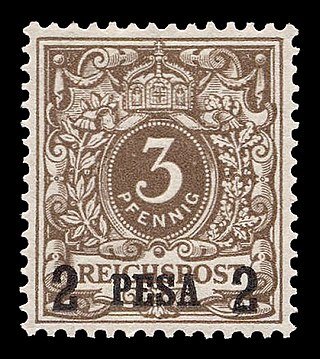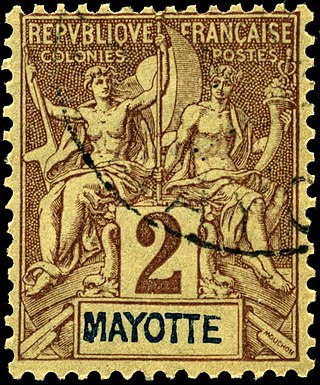



The postage stamps of New Guinea , part of present-day Papua New Guinea, were issued up to 1942. [1]




The postage stamps of New Guinea , part of present-day Papua New Guinea, were issued up to 1942. [1]
In German New Guinea, in the Bismarck Archipelago and the North Solomon Islands, the first German post offices opened in 1888 and used some stamps of the German Reich, issued between 1875 and 1887 (denomination in an oval or imperial eagle series). [2] On the mail, they were cancelled with a round datestamp bearing the name of the town in the upper part and a five arm star in the lower. The "DEUTSCH- / NEU-GUINEA" mention appeared in the middle of datestamps some years after, and there can be two or three stars. [2]
In 1897 and 1898, six stamps of Germany were overprinted with the name of the colony, printed in diagonal on two lines. [2] It is in 1901 that the first stamps were issued with the name of the colony printed on them, in the German colonial series, picturing the imperial yacht Hohenzollern . [2]
When the Australian Naval and Military Expeditionary Force occupied German New Guinea in 1914, it met the need for postage stamps by overprinting existing stocks of the (unwatermarked) German New Guinea and Marshall Islands stamps with "G.R.I." (short for Georgius Rex Imperator, referring to the incumbent British King George V). Values ranged from one penny to five shillings, and roughly corresponded with the values of the original stamps expressed in pfennigs: 1d on 3pf and 5pf stamps, 2d on 10pf and 20pf, and so forth.
The Australians issued a first setting of the overprint on 17 October 1914, followed by a second setting (with slightly different spacing) on 16 December. In all, they produced some 50 distinct stamps.
In addition, Australian postal authorities pressed registration labels into service as 3d stamps, overprinted in the same way as the others. Labels of the Friedrich Wilhelmshaven, Herbertshöhe, Kavieng, Kieta, Manus, and Rabaul post offices became overprinted in this manner.
Because of the short period of use of these issues, they occur quite rarely, and command high prices; the most common denominations cost at least $15 US a piece, and the five-shilling overprints fetch prices of over $10,000 on the rare occasions when they come up for sale. In addition, the overprinting process produced a number of errors, and these also command high prices.
In 1915 these improvised stamps of New Guinea were superseded with stamps of the "North West Pacific Islands".
In 1925, the Australian administration in the League of Nations mandate of the Territory of New Guinea issued the first stamp series.
With the Japanese attack on Rabaul in New Britain in January 1942 and the occupation of the rest of the territory, the civil administrations were eventually suspended.
After World War II, the territories of Papua and New Guinea were combined in an administrative union as the Territory of Papua and New Guinea.

An overprint is an additional layer of text or graphics added to the face of a postage or revenue stamp, postal stationery, banknote or ticket after it has been printed. Post offices most often use overprints for internal administrative purposes such as accounting but they are also employed in public mail. Well-recognized varieties include commemorative overprints which are produced for their public appeal and command significant interest in the field of philately.

This is an overview of the postage stamps and postal history of Australia.

This is a survey of the postage stamps and postal history of German East Africa.

Early mail sent to and from the Caroline Islands was occasional and dependent on visiting ships.
Each "article" in this category is in fact a collection of entries about several stamp issuers, presented in alphabetical order. The entries themselves are formulated on the micro model and so provide summary information about all known issuers.
Each "article" in this category is in fact a collection of entries about several stamp issuers, presented in alphabetical order. The entries themselves are formulated on the micro model and so provide summary information about all known issuers.
Each "article" in this category is a collection of entries about several stamp issuers, presented in alphabetical order. The entries themselves are formulated on the micro model and so provide summary information about all known issuers.
Each "article" in this category is a collection of entries about several stamp issuers, presented in alphabetical order. The entries are formulated on the micro model and so provide summary information about all known issuers.
Each "article" in this category is a collection of entries about several stamp issuers, presented in alphabetical order. The entries are formulated on the micro model and so provide summary information about all known issuers.
Each "article" in this category is a collection of entries about several stamp issuers, presented in alphabetical order. The entries are formulated on the micro model and so provide summary information about all known issuers.
Each "article" in this category is a collection of entries about several stamp issuers, presented in alphabetical order. The entries are formulated on the micro model and so provide summary information about all known issuers.
Each "article" in this category is a collection of entries about several stamp issuers, presented in alphabetical order. The entries are formulated on the micro model and so provide summary information about all known issuers.

The Yacht issue was a series of postage stamps, bearing the image of German Kaiser's yacht, SMY Hohenzollern II, that were used in all of Germany's overseas colonies. Millions of stamps were produced and they were the principal means of postage for all German imperial overseas possessions in the years 1900–1915. German colonies at that time were German Samoa, Kiautschou Bay, Togoland, Kamerun, German New Guinea, German South-West Africa, and German East Africa.
The postage stamps and postal history of the Comoro Islands is an overview of the postage stamps and postal history of the Comoro Islands, an Indian Ocean archipelago located on the south-east side of Africa.

This is an overview of the postage stamps and postal history of the Indian Ocean island of Mayotte, one of the Comoros Archipelago islands located on the south-east side of Africa.

The postal history of Turkey and its predecessor state, the Ottoman Empire, dates to the 18th century when foreign countries maintained courier services through their consular offices in the Empire. Although delayed in the development of its own postal service, in 1863 the Ottoman Empire became the second independent country in Asia to issue adhesive postage stamps, and in 1875, it became a founding member of the General Postal Union, soon to become the Universal Postal Union. The Ottoman Empire became the Republic of Turkey in 1923, and in the following years, its postal service became more modernized and efficient and its postage stamps expertly designed and manufactured.

The postage stamps and postal history of Christmas Island, in the Indian Ocean, was linked to its original economic situation until 1993. Mainly ruled by a phosphate production commission, the island was part of the British Straits Settlements colony from 1901 to 1942, then of Singapore from 1946 to 1958. Although it was placed under Australian control in 1958, the island remained postally and philatelically independent until 1993 when Australia Post became the island's postal operator.

The postage stamps and postal history of Papua New Guinea originated in the two colonial administrations on the eastern part of the island of New Guinea and continued until their eventual merger, followed by independence in 1975.

The postage stamps and postal history of Norfolk Island depended on Australia until 1947, when the island, an Australian territory since 1914, received its own stamps and postal autonomy.

This is a survey of postage stamps and postal history of the German colonies and part of the postage stamps and postal history of Germany, as well as those of the individual countries and territories concerned.